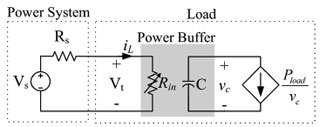Mitigation of Power System Collapse through Active Dynamic Buffers
Wayne Weaver with adviser Philip Krein
Modern power electronics can destabilize or even collapse a power system by acting as constant-power loads. These types of loads are becoming more prevalent at all power levels. Examples include advanced industrial motor drives, computer power supplies, compact fluorescent lighting, high-power supplies with active front ends, active filters for power quality improvement, and other converters with active power-factor correction. Unfortunately these constant-power loads impose negative impedance instabilities. In extreme cases, the problems can lead to system-wide voltage collapse. As fast dynamic constant-power loads continue to penetrate the market, the potentially harmful effects of negative impedance during system transients and voltage sags grow.
One method to mitigate the destabilizing effects of constant-power loads is the powerbuffer concept. A power buffer is a device that presents controlled impedance to the supply system while constant power is delivered to a load. A power buffer may include additional hardware, or merely modify the controls of an existing active front end. A simple conceptual model power system with a power buffer and constant-power load is shown in Figure 22. A geometric manifold control approach has been developed that simplifies the buffer algorithm to a unified control law that can be applied to a wide range of active front ends. Optimal control theory was used to determine the manifold that extends the buffer’s sustaining time while enhancing its stabilization characteristics. For an example 208 Vac 3-phase system and a 1 kW constant-power load, this buffer design can mitigate a voltage sag of magnitude and duration that falls in the shaded area of Figure 23. Through experimental results the proposed control has been shown to negate the effects of constant power.

